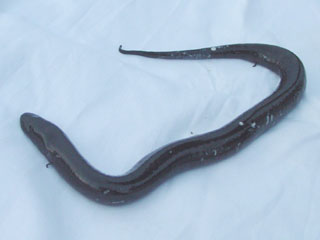|
| 질의: Caterpillar | 결과: 1395번째/1696 | |
Two-toed Amphiuma (Amphiuma means) - Wiki
| 제목: | Two-toed Amphiuma (Amphiuma means) - Wiki
| |

| 해상도: 320x240
파일크기: 20022 Bytes
촬영일: 2003:10:08 14:10:24
등록시간: 2007:01:26 14:05:30
|
ERROR : Server Busy(-1105)
ERROR : Server Busy(-1105)
Two-toed Amphiuma (Amphiuma means) - Wiki
Two-toed Amphiuma
From Wikipedia, the free encyclopedia
[Photo] Amphiuma means. From http://www.pwrc.usgs.gov/armiatlas/species.cfm?recordID=173609
The Two-toed Amphiuma (Amphiuma means) is a snake-like Salamander found chiefly in the southeastern United States. It is commonly, but incorrectly, called Congo Snake, Congo Eel or the Blind Eel. It has a thick body about 36 inches (91 cm) long, four vestigial legs that end in two or three toes which are virtually useless, and eyes with lids. It is of blue-black colour. They feed on small fish, snails, and insect larvae; it is harmless to humans although they can deliver a tough bite. Unlike other salamanders, which are mute, the Congo snake gives a clear whistle when disturbed.
http://en.wikipedia.org/wiki/Two-toed_Amphiuma
| The text in this page is based on the copyrighted Wikipedia article shown in above URL. It is used under the GNU Free Documentation License. You may redistribute it, verbatim or modified, providing that you comply with the terms of the GFDL. |
|
^o^
동물그림창고 똑똑전화 누리집
^o^
|
|